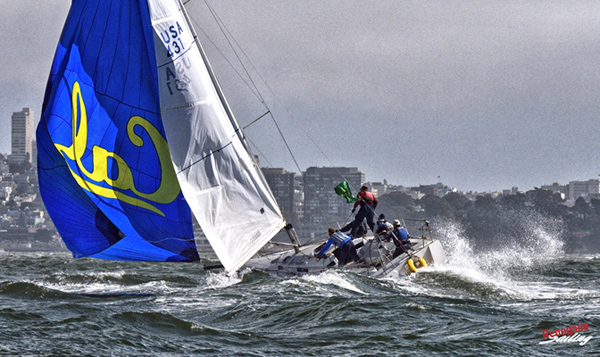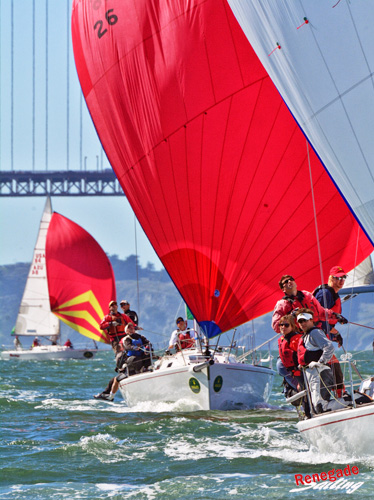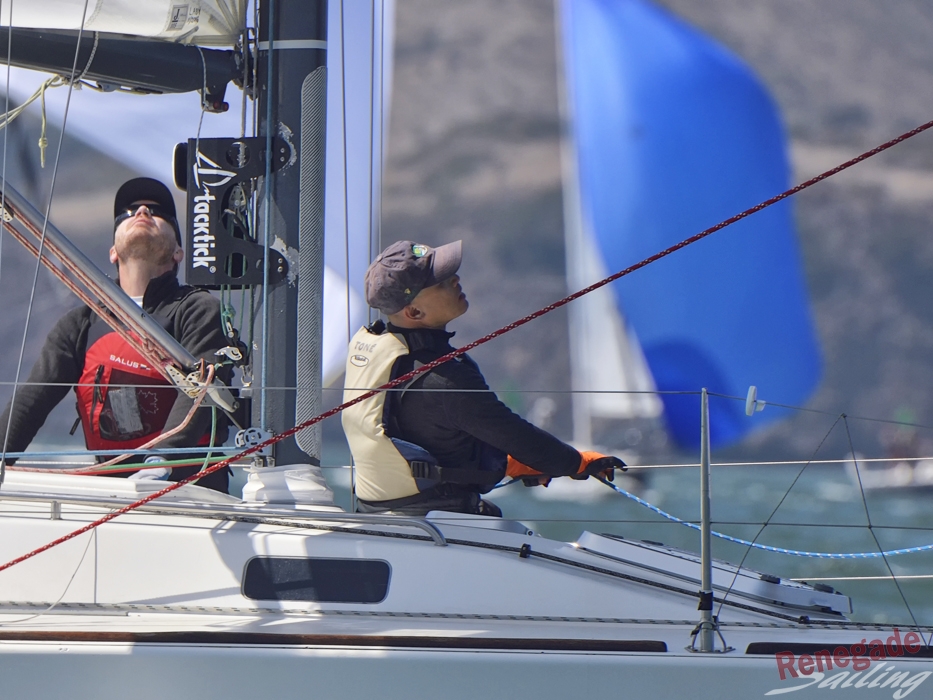Read about the Favorite Boat of San Francisco J105 Sailboat
Within the U.S., the San Francisco J/105 remains one of the most successful one-design keelboat classes in the over 30-foot range, with major fleets located in Chicago, Annapolis, San Diego, Houston, Marblehead, Cleveland, Seattle and San Francisco.
There are two international fleets: J/105 Canada class in Toronto, ONT, and the J/105 Chile Class. Shares J/Boats executive Stuart Johnstone, “We also ‘technically’ have fleets on the Solent in the U.K. and the Netherlands, but rarely more than five to six vessels show up for events.”
San Francisco J/105 Fleet 1 lists 73 member boats, which makes it the largest and likely most active, one-design on the Bay. What’s the recipe for success? Much of it starts with an invention in 1991.
A Design For Success
In the late 1980s/early 90s, having routinely participated in the Ultimate Yacht Race series for Ultimate 30s and One-Design 14s, Rhode Island brothers Stuart and Peter Johnstone got an idea to create a keelboat that relied on the same simple sprit + asym combo of these two boats. Not an outlandish notion—being members of the J/Boats legacy known for their top selling models J/24 (introduced in 1977) and J/22 (introduced in 1983).
In 1990 the duo approached their 63 years old father. Shares Johnstone, “Fast is fun when it’s easy! So, our next design was either going to be a 23 foot J/70 or the 34.5 foot J/105. My dad (Bob) won that debate since he wanted to sail in comfort both offshore and around the buoys.
We initiated design on the J/105 (LOA 34.50 foot) in 1991.” An interesting tidbit—the J/105 design was also based on input from the late Sir Peter Blake. Adds Johnstone, “We were engaged in working on a J/65 offshore racer for the Whitbread Race (Volvo Ocean Race).
Every time we ran the J/65 design through Peter’s global weather model it got faster. In other words, the design got beamier and flatter aft.” Requirements for that J/65’s offshore, fast-reaching machine ended up shaping parameters for the J/105, as well as an eventual J/65 cruiser, a custom build model.
This article was the cover feature in February 2017 Latitude 38. View San Francisco Bay the J105 article and photos.
Twenty five years later and the J/105 remains incredibly popular, surpassed in sales only within the last three years (35 to 37 foot marketplace) by the J/111 model. Globally, more than 680 J/105 boats can be counted.
What started off as a vision to be a fun offshore PHRF boat easily handled by five or six crew, has become a one-design class with longevity.
Johnstone says, “We see strong ongoing demand for its purchase as a used boat, and the investment is not only affordable but preserves in value. In Europe it has become a de facto single or double-handed boat in IRC/ORC events in the RORC and European offshore circuit.
The J/105 has won the Fastnet Race in the 2H class three times, plus several RORC channel races. Crews have campaigned J boats to wins in the Transpac race in double-handed, as well as full crew, divisions on more than one occasion.”
San Francisco J105 Lore and Legacy of a First: Fleet 1
San Francisco fleet 1 was formed in 1994 by Don Trask, the J/Boats dealer in Alameda, plus Art Ball and Chris Corlett who sold and promoted the boat. Today, the group is very active in local racing, and major regattas can draw 25 or more boats to the start line. Crews race year round with tier A and B events.
A events require the boat must be weighed by the fleet measurer. A events stipulate a weight limit of 1,044 pounds, and there is a new sail limit of no more than two or three per year, alternating.
Additionally, the skipper must be an owner (with some rare exceptions). The class permits only Category 1 sailors (non-professionals), although a full owner may be Category 3 sailor (professional). B events are not governed by requirements of A.
One veteran skipper/owner is Theresa Brandner, owner of Walloping Swede. A dedicated A series racer, Brandner has competed right up to 8.5 months into a pregnancy.
And once her daughter was born she joined after only two months. Tucked safely below within line of sight, she always responded with a squeal of happiness when mom talked to her from the above cockpit during the time that the boat was being delivered to and from the races.
Another fun fact about Brandner: a vendor is marketing her t-shirt design that says “I used to chase the boys, now I pass them,” accompanied by the Lima, AKA “Follow me,” flag.
This group has personality. Names such as Natural Blonde, Hazardous Waste and We Be Jammin’ can be seen. One competitor reveals there’s a skipper who knows, and apparently sings, every word of T-Pain’s “I’m on a boat.”
Brandner adds, “During the dotcom boom everyone wanted a J/105, including people who hadn’t really raced before. We saw more than 33 boats on the start, so chaos was expected. There were a lot of collisions, protests, drama, and the fleet developed a very bad reputation.”
Around 2004 an annual mandatory rules/tactics seminar, with a penalty on an owner’s season score if the boat did not show up, was established. “That helped. Collisions and protests are far more scarce now.”
Gunning it at ROLEX Big Boats San Francisco J105
San Francisco J105 fleet bowman Tone Chin is a regular Fleet 1 racer. Just before the 2016 ROLEX Big Boats Series in San Francisco he quietly asserted, Watch Godot. We’ve got a shot at winning it.” Chin, one of three recent crew pick-ups last season, was all grins at the St. Francis Yacht Club day three of competition.
After a rough start (15 – 3 – 7 finishes in a division with 26 boats), the crew pulled together on remaining race days to strike 1 – 1- 1- 2. As a result, they just edged past Blackhawk for the Rolex win. Owner and skipper Phillip Laby wrapped the season with not only a 2016 Big Boats success, but recognition for being overall best of the fleet for the year.
Laby, a Southern California native who grew up racing Lasers and similar small boats, has been active in Fleet 1 competition for several years. Following a move to San Francisco Bay Area in 2006, plus a 20-year sailing hiatus, he re-engaged with the sport spending time with various local fleets.
“I came to favor being aboard a J/105 boat,” he exclaims. “The San Francisco j105 fleet 1 is large and competitive—both attractions for me.” Within a year he and boat partners Rich and Mary Pipkins had acquired hull 375, Racer X.
Says Laby, “We had a lot to learn and climbed a steep curve. The first year saw too many shrimps, fouled maneuvers, third row starts and lots of upwind speed but no point. In 2008 we finished 8th overall, the following year 7th, and broke the top five with a 5th in 2010.”
They raced together for approximately three years prior to an amicable parting in 2011 (the Pipkins now campaign Racer X in single-handed events) when Laby came upon hull number 44 Orion. When hunting to purchase, he opted for models built in the early nineties.
“The newer boats came with more bells, whistles and inventories, but I sail with a minimum of instrumentation. The older boats were less expensive, and since I was moving from a partnership to a solo program I favored the cost savings.”
Renaming the boat to Godot has a story, “I reference the 1950’s play “Waiting for Godot” by Samuel Beckett, in which the main characters wait endlessly for the arrival of the infamous Godot.
In the meantime, the audience experiences the characters’ friendships and how their shared vision binds them together. Pursuing a vision connects us to our passions and those with shared interests. Naming my boat Godot helps remind me it’s all about the journey.”
He immediately set to building a team. “There is plenty of talent in the Bay Area, but once a crew is assembled systems need to be worked out. A primary challenge was learning what to focus on and when to trust. This became easier as my roster filled with more skilled crew.” Second, Laby had to figure out how the boat responds.
“Knowing when to press on the gas, or pull-in the sails is critical. Being in sync with the crew and knowing how quickly each can respond has a big impact on execution–especially critical at the starts, but also at any crossing or rounding. In the beginning I used to count and time much more than I do now; today it’s more instinctual,” he smiles.
On San Francisco Bay learning is that much more challenging for each execution. Not as familiar with the local conditions as his peers, he used to follow the leaders. “I had no idea where I should be going! Sometimes they lead us to success, other times not so much. The last couple years I have gained confidence in my own knowledge.
In 2016 I started discussing strategy with the crew. We now have the confidence to follow our convictions. And as a result we now tend to lead to the favored places, as opposed to follow; this has elevated our sailing to a new height.”
In 2014, ‘15 and ‘16 Godot earned a Fleet 1 ranking within the top three spots. A note about this skipper—he’s also the mainsheet trimmer—a rarity when racing in Fleet 1. In 2017 Godot will complete the full Fleet 1 schedule. Laby may also head to the 2017 J/105 North American Championship at Lakewood Yacht Club in Seabrook, Texas, in October. Obviously that would be a time and cost commitment–as a father and tech start-up executive his schedule is already full. “All told, we’ll be on the water at least 30 days for competition, plus days for practice.” Sailing in San Francisco Bay J105.


San Francisco J105 is Enduring Fleet and Design Success
Success of fleet 1 is tied to popularity of the J/105 boat—called an ideal for Bay conditions. She is able to withstand strong and unpredictable winds. She is quickly rigged and the asymmetric spinnaker on bowsprit streamlines operations.
There’s ample cockpit space plus a fair amount of room below.
And the Sam Francisco J/105 has been deemed a great value. When it comes to racing, the playing field is fairly level for this class, as rules dictate an owner-driver rule, tight restrictions on Category 3 professionals and annual sail purchase restrictions that keep racing affordable and as Corinthian as one-design can be.
For the J/Boats Company, the J/105 has been so successful that it ultimately influenced the design for all future models: successive boats always incorporate the sprit + asym configuration. Shares Johnstone, “As a matter of fact, J/Boats was the first company in the world to mass produce asymmetric spinnaker keelboats starting in 1991.
The only precursors were primarily dinghies–International 14s (U.K.), International 12s (New Zealand) and Aussie 18s (Sydney, Australia). The Ultimate 30s were all custom boats with lightweight keels, but followed the same basic idea. The world followed J/Boats’ innovation.”

I used to chase the boys. Now I pass them.
